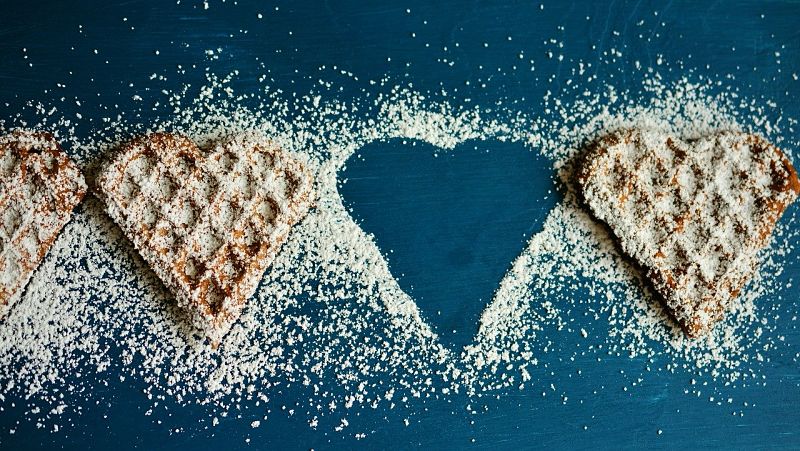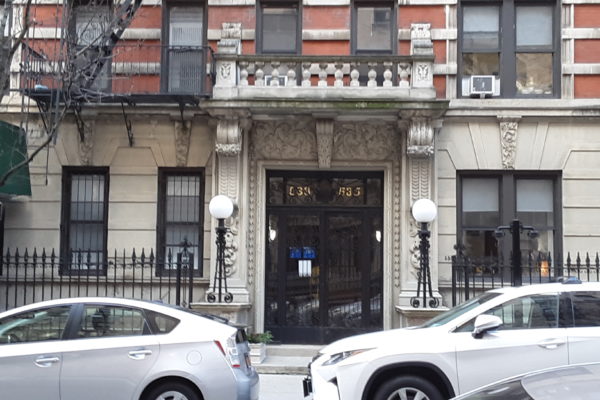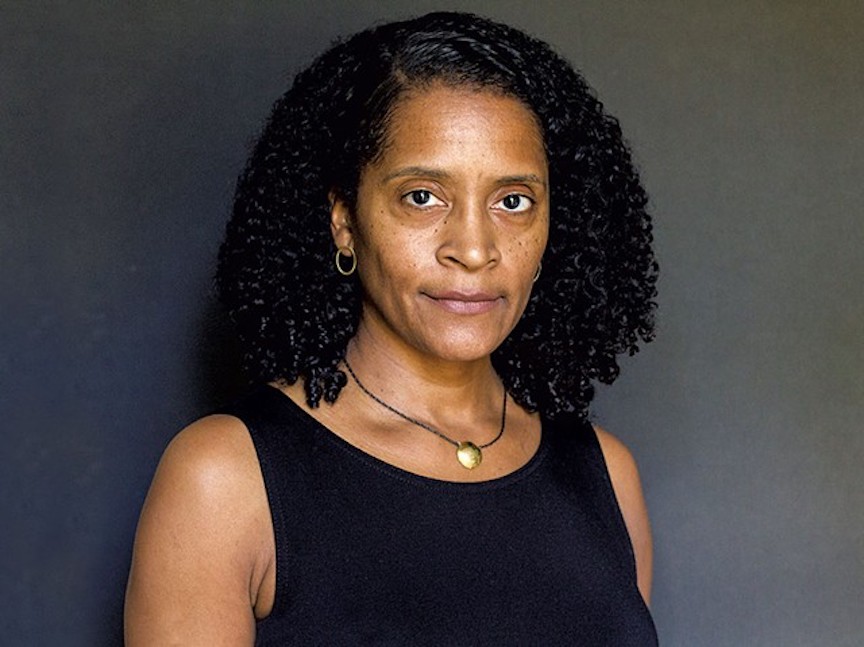I wake up with a Pangea of hives across my torso, stomach more red than white, blanching splotches tendrilling down my legs and up the inside of my arms. They went away over the weekend but are back now, pinpricked Monday night leeching into swollen Tuesday morning. I roll over, announce to my girlfriend Emily that I “definitely have leprosy,” and unpeel the covers to show her. She looks away in horror and I re-sheet myself. I don’t blame her. I’m disgusted too.
When I can stomach the thought, I pull myself out of bed. I snap a photo of my contorted body in the mirror and send it to my mother for her opinion. She immediately texts me back, three little blue bubbles side by side.
Mom: “?”
Mom: “Have you eaten anything today?”
Andersons show their love in food. We begin planning for dinner as we sit down for lunch. Mealtimes are sacred, the extended family sheltered around the big wooden table and smaller folding table that someone always remembers to bring. Mom’s family is much the same: extravagant, three-course Thanksgivings with cookie jars full of tiny Krackel bars and fridges stuffed to the brim. Laughing over beers. Mom had a bakery before starting the brewery.
Food takes on the shapes of comfort, of love, of extending a hand when no one is there to greet you. When I went to college, Mom compiled all of the family recipes and put them in a Google Doc with a shitty clip art cover, dated and printed and binder-clipped together. It’s held up despite the standard cooking messes: when Grandma died, I made the petit fours she boxed up for us at Christmas even though it was September; when I missed home, I made chocolate chip cookies whose recipe we stole from the back of the Tollhouse bag; when I hosted Friendsgiving for the first time on my own, I made two pots of beef and non-beef stew for the ten friends who didn’t fit in my living room.
Naturally, then, the anger that formed and bubbled up and out as I grew revolved around food as well.* Mom always had food allergies, so learning how to work around and ignore food became second nature. I developed a peanut allergy young but still refuse to stop eating them. Days one through three of peanuts are fine, but day four brings on a legume cold and day five is more like a flu. I try not to let it get past day five but sometimes I am angry and a Reese’s from the freezer is the only ice pack I have.
Even when I was thirteen and trying to steamroll through anorexia recovery, Mom kept dieting. Diets were never about the way the body feels, but the way the body behaves. A punishment. A sense of destruction. A frozen candy when I already sound like I did when I had whooping cough in high school.
They say eating disorders are inherited – half nature, half nurture. My maternal grandmother, Martha, struggled with them her whole life diagnosis-less.** She stopped eating long before her last stroke. She was easily the meanest of my grandparents. I don’t know if I could have gotten soft, reassuring conversation ending in a hug from her. Meanwhile, Mom ate coconut ice cream and soymilk before slowly cutting back all food. She swore off sugar and gluten and processed foods. Before long, they all came rushing back into the fridge. They call it yo-yo dieting for a reason.*** So I watched, and I learned, and the first time I went 24 hours without food I was nine and my maternal grandmother, my Nana, cried trying to get me to eat bagel bites while I sat on the swing we installed in my childhood basement in silence.
The other thing about eating disorders is that they’re inherently messy. There is eight months of blankness in my memory from malnutrition and starvation that I will never get back. The few things I do remember were screaming and swearing and clenching my fist so tight around some semblance of ritual because Becca was just diagnosed with Type I diabetes at age eight and Mom was still bringing me to Weight Watchers meetings and every indefinite grocery store trip with her even when the hoodie I hid in every day was getting bigger, and bigger, and bigger.**** She has twice gasped and questioned “where did half of you go?”, once when I took that hoodie off, and once in college when my body stopped absorbing nutrients as the celiac disease kicked in and I lost 50 pounds. I was left with a mauled body, forced to learn its intricate quirks and higher-than-before risk of osteoporosis and infertility, something that I can cradle as much as I want but cannot unstretch.*****
Mom: “You should really check with your doctor about it – make sure it’s not autoimmune.”
The infamous Andersonian question: is my body doing this just for kicks, or is it because of a serious underlying autoimmune disorder? As far back as the eye can see, histaminergic inheritance goes haywire.
The first time I got hives, I was twelve and noticed them post-shower. I figured it was my sensitive skin’s reaction to a new one-dollar shampoo, but my skin didn’t feel any better when I switched back to my pomegranate Garnier. Rather, the hives got worse.* The allergist said it was aquagenic urticaria, that it happens to one in three teenaged girls, but I’ve never met anyone else who has it and the Genetic and Rare Diseases center of the NIH says there are only 50 recorded cases in the United States. I sweat, I cry, I shower, I swim, I break out in hives. It comes and goes. The allergist told me I’d grow out of it in “three months to three years.” It’s been ten and I still have to tune out the itch that settles in during a good workout. There are 51 cases if you count me.
If you read the Wikipedia page on autoimmune diseases, I can name a family member for each one. Some of them – Addison’s, diabetes, vitiligo – have generations tacked on their bullet point. One of my earliest memories of my father is him wiggling his vitiligo-covered index knuckle at me and crooning that “cow finger says ‘moo’” and I laughed so hard that I vomited all over the dinner table. Most of the autoimmune diseases are just things that we have to learn to live with, minor lifestyle adjustments and new family songs, stacking up like the world’s most unsettling game of Connect Four. Before long, no one can stack any bullet points higher and something else falls.
The only grandparent of mine that is no longer with us is the only one who never expected to die. Martha started having strokes monthly in her early 30s and had them up until the big one that crept silently until it blew through ¾ of her brain in 48 hours at 75, more years of strokes than periods.** But she always bounced back. Maybe with a limp or a slight slur in her voice annually or so, but she always came back. Thrashing command or normalcy when there couldn’t be otherwise, through scarlet fever in early childhood can do that: instilling the idea that you just have to fight through anything, that you can and should. It’s that same stubbornness that I couldn’t avoid. Her husband has had three aneurisms, but his 80-year-old soy-sauce-soaked brain is still ever-steady.
When I wanted to be tested for celiac last year, the doctors told me I’d test negative even if I had it if I kept eating gluten-free because my body would have stopped destroying itself. After three purposefully excruciating months of low-grade fevers and near-daily migraines and arthritis-esque joint pain, every immunoglobulin result came back a big, black zero. They said that meant I couldn’t have celiac, that I probably just have a sensitive microbial circus.*** They didn’t bother to ask about the inheritable IgA deficiency that almost killed Nana when she got MRSA in the hospital and had to go six months without knees and then didn’t get diagnosed for ten years after that, or the fact that vaccines never seem to stick to me, because it’s weird and no one has that.
But I went back to my dense, disappointing crumbly crackers and felt fine.****
I can live with celiac, but it’s the things like seven recorded generations of type II diabetes that scare me. I have Martha’s penchants for mid-century furniture and reading and swearing and obnoxiously patterned socks, I had Nana’s mother’s middle name until I outgrew it, I have Pépère’s mom’s mysterious PCOS-drawn facial hair that everyone just assumed she had because she was Quebecois. Sometimes I feel self-conscious because my life is plagued by things that are supposed to mostly affect women but I’m not one. There’s medication I take for that too.*****
My family, full of love and good intentions,****** has created a waiting game. I am teetering on edge, waiting every day for a slight shift to the left out of normality and into a fog. My dad taught me how to check for vitiligo spots under a black light. I can’t think about calories or else a week will pass without me in it.
New symptoms are documented and then systematically ignored.*******
The thing about non-allergy hives is that their genesis is almost impossible to parse. Their lifespan is dictated by the reabsorption of the cellular fluid that leaked out of capillaries by histamine’s request. So when they show up without reason, routine shifts to living around bumps. What else can you do? Control comes from the outside in, spiraling through a body whose entropy can never be measured.
After showering, comparing the genealogy of the hives grown from bottom-up stress and top-down scalding water, I join Emily in our cramped apartment kitchen. At least here we can stand next to each other and also have the fridge open – we couldn’t do that when we lived together in central Ohio and there is gratitude in the little things.******** She has already pulled out a bowl and the last half-box of gluten free pancake mix from the crate that my aunt sent us when we moved in. She rustles around in the fridge for an egg and I step inside the box of fake-wood vinyl flooring. It becomes a sort of dance: she adds an ingredient, spins around to open the waffle iron; I duck in and grind espresso beans, swirl under her arm and almost hit my head on the fridge handle trying to grab the espresso machine off the stovetop but don’t.
We are two music-box dancers in offset synchronicity. I use the non-gluten sponge to clean batter drips off the cracked countertops when Emily isn’t looking. The espresso machine whistles and I pull it off the heat, trying not to drip anything on the stovetop. Our kitchen smells like fresh waffles and handmade cappuccinos and is still messy and still perfect. I draw smiles on our waffles with whipped cream.
That night, we make dinner with the same movements, a routine perfected by two years of shared stovetop custody: Emily chops and roasts honey-colored bell pepper, listens to it crackle as she mixes it into pesto and homemade marinara and a euphony of spices; I angle a dough hook into pao de queijo batter and drop gluten-free spaghetti in the pot on the stove, the only brand that doesn’t make the water carbohydrate-slurry. This custom, this kitchen, this connection.
In the morning, the hives will be gone.
Photo Credit: Congerdesign from Pixabay
______________________________________________________________________________
* I have always been a full china cabinet on moving day.
**Martha had a pixie cut her entire life and never once wore a dress. I never understood why she had children. She hated them, hated me until I was old enough to know that the way to get to know her was to read next to her on the couch in silence. Then she liked me best.
***There are two types of histamines found in the human body, aptly named H1 and H2. H2 is most well-known for its role in regulating digestion.
****Push it down and continue on.
*****Histamine H1 receptors, which in excess create hives, are also found in the uterus.
****** If I have children I will never bear them myself. Partially, it is one of my greatest fears to feel something growing in a part I was never supposed to have. I tell my mother my favorite no-children-or-childbirth joke, that I “don’t want to grow bones I don’t get to keep” and she calls me selfish. It is true.
*******Partially, subjecting a child to the experiences of my family and myself feels more inhumane than the love I could bear to give them.
********Emily and I have talked about having children exactly once and we dropped the subject as soon as it came up, but I see the way her eyes soften when she looks at the sourdough starts on the countertop. She named them William and Ari.




